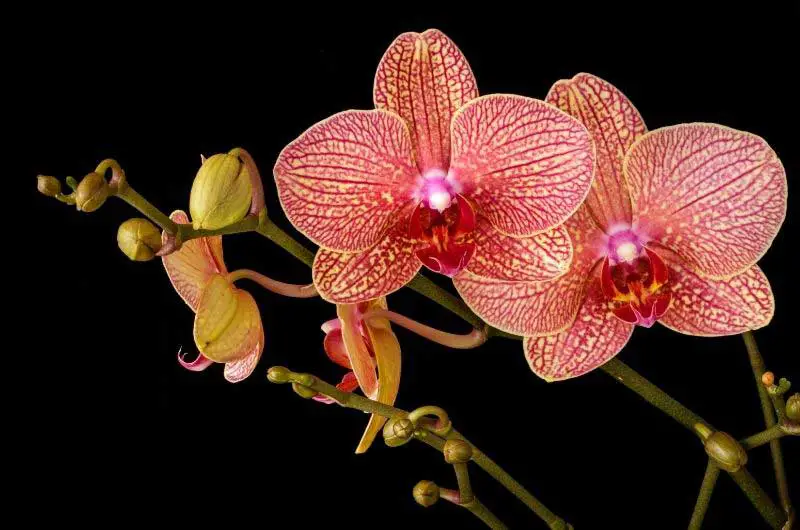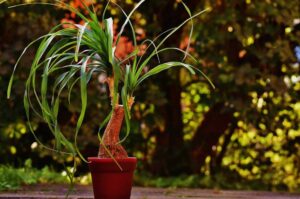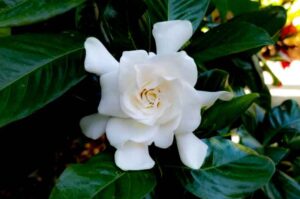How Long Can Orchids Go Without Water?
Orchids are beautiful plants that do not do well when they are overwatered. However, they do have a bit of tolerance for being underwater.
Orchids are a common plant in many households, and a lot of people wonder how to prevent their Orchids from drying when they are out of town or can’t care their Orchids for some reason.
In this article, learn how to water your Orchids and how long they can survive without water.
How Long can Orchids Survive Without Water?
It depends on the overall health of your Orchid, the potting medium, the humidity and lighting conditions, and the health of its roots. Based on these factors, your Orchid may be able to go up to two months without water. However, this is rarely recommended.
Generally, Orchids are watered once every week or two, and less frequently during their dormant period. In this article, we’ll cover how frequently to water Orchids during different parts of their growth cycle, whether your Orchid is resistant to drought, and three environmental factors you can use to help your Orchid thrive if you’ll be away for a long time.

Here are the factors that decide, how long can an Orchid survive without water
- Orchids with canes can survive longer
- The growth cycle of Orchids
- Humidity levels
- Environmental temperature
- Potting soil
Orchids With Canes Can Survive Longer
One of the major distinctions between Orchids’ differing abilities to withstand drought is whether the plant produces pseudobulbs, also known as canes. Canes look like a thick, fleshy stem, somewhat similar in appearance to bamboo, but much softer. These canes help the plant store water, and Orchids that produce canes have a native habitat where they experience periods of drought.
If your Orchid has canes (such as in Dendrobium Orchids), it will be much more tolerant of periods of drought than an Orchid with no canes (such as the more common Phalaenopsis).
Depending On The Growth Cycle of Orchids
Getting to know your Orchid’s cycle will help you know how much to water and fertilize it. Orchids have four phases to their growth. First, leaf growth, where the Orchid puts out a new leaf to help it photosynthesize and get the energy it needs to grow roots and buds. Next, root growth, which helps it get more water. Third, budding and blooming—the best part. Finally, dormancy.
During dormancy, which occurs right after blooming, the plant will not need as much fertilizer, light, or water. This is also the time when some people recommend cutting the stalk that has finished blooming. (Opinions are divided on whether this helps the plant rebloom, or steals the nutrients it’s using to grow).
During the first three growth stages, the plant needs to respire actively and hence need more water and nutrients, while during the fourth stage i.e. at the dormancy stage, Orchids don’t need a lot of water or fertilizer.
Blooms, on the other hand, are the most delicate part of the cycle, and underwatering will cause the flowers to drop much faster than otherwise. Orchids such as the Phalaenopsis can retain their blooms for as long as four months. If you are planning on leaving your blooming Orchid for a long period of time, it would be best to set up a watering system or have a friend plant sit for you.
How Frequently to Water During Growth Period?
During growth periods of your Orchid (leaf growth, root growth, and budding), you should water your Orchid about once a week. More importantly, you should check whether your plant has gotten dry.
Orchids without pseudobulbs should not fully dry out, while Orchids with pseudobulbs may be allowed to fully dry out before watering again. This will be more often if it’s in high-light or a very dry or breezy environment, and less often if it’s colder or more humid.
How Frequently to Water During Dormancy?
During dormancy, you can usually decrease your watering frequency by half or more- every two or three weeks, rather than every week. If you’re going to accidentally forget to water your Orchid, dormancy is the most forgiving time, since the Orchid is not actively growing as fast.
Indeed, for Orchids with pseudobulbs, many species do best if they are very seldom watered during the dormancy period, and may suffer no adverse consequences even if left without water for up to two months.
During dormancy, be sure to place your Orchid in a cooler place to help lower its metabolism. Otherwise, the low water period may be more damaging to your plant.
Depending Upon the Humidity Levels
Incredibly, Orchids can absorb a small amount of water through their leaves and roots straight out of the air. Thus, if the air is more humid, your Orchid will be able to live longer without watering.
Some people like to leave their Orchid pots above a pebble tray and water in them to increase the local humidity near the plant. If you do this, make sure that the pebbles keep the pot above the water in the saucer.
Another way to increase the local humidity is to put your Orchid near other plants. If you’re creating a self-watering system for any non-Orchid potted plants, placing your Orchid near them while you’re gone will definitely help it weather the wait.
A humidifier can also keep the environment humid.
Depending on the Atmospheric Temperature
Cooler temperatures will help your Orchid do better in long dry spells. You should consult a culture sheet, which will tell you what lows your Orchid prefers, such as those provided by the American Orchid Society.
However, you should not lower the temperature to help your Orchid through a dry spell while it is in bloom.
The flowers are very sensitive to temperature changes and may drop unexpectedly if you make a dramatic temperature change. You may notice this in commercial floral arrangements: Orchids that are exposed to a draft, such as those in a lobby in winter, will lose their flowers much faster than the one you care for at home.
Ideal Potting Medium for Orchid to Survive a Water Scarce condition
One of the easiest ways to help your Orchid stay happy while you’re not at home is to change the potting medium. Sphagnum moss is often a part of Orchid potting mixes, and its role is mainly to absorb and slowly release water to your Orchid’s roots.
In fact, many commercially grown Orchids are packed and displayed in 100% moss! Thus allowing them to be watered very infrequently when they are being shipped or loaned to businesses for their lobbies.
You might be thinking, “Wow, I might be able to water my Orchids just once a month if I use a water-retentive potting mixture like moss!” But using moss as a long-term potting media is inadvisable.
Being packed tightly in damp moss can lead to root rot, as the roots are constantly moist and cannot access the air. For this reason, you should try to only add lots of moss for the periods you will be away. Once you’ve worked the moss into the roots, soak the roots and potting media thoroughly before draining, and your Orchid should have enough water for up to one month.
How Often Should Orchids be Watered?
Many people make the same watering mistakes which end up killing their Orchids. Some Orchid watering practices can help your Orchids remain healthy for a long time. Before that take a look at the common watering mistakes made by most people.
- Watering the Orchids too often – Most people end up watering their Orchids regularly when ultimately overwaters their plants. There should be proper gaps between the Orchid watering sessions and most importantly, a long pause from watering the Orchids during winters.
- Watering at night – Always water your Orchids in the morning. At night there is a high chance that the water will stagnate which can risk rotting the roots of the plant.
- See the cues – Orchids are good at communicating. Take a keen look at what your plant needs and you will save yourself from making mistakes. In the growing season, the pseudobulbs are fat and plump and the plant has fleshy, healthy leaves. In winter, however, the plant might shrink.
You need to know your plant to stop making such mistakes.
How Do You Keep Orchids Watered While on Vacations?
Most Orchids will survive for two to three weeks without water, some occasionally up to one month. Cattleyas, Dendrobiums, and Phalaenopsis, all these common species of Orchids will survive up to three weeks during a typical, 2 to 3 weeks’ vacation period.
This is only if they still have some medium of moisture like wet moss, wet pebbles, ice, stones, or other methods to keep the area humid and moist, even after the water has evaporated. Only a few varieties get damaged by drying up completely.
Here are some tips to keep your Orchids watered when on vacation.
- Soak your Orchid medium in water for thirty minutes or more the day you leave. Though there is no fixed time limit, the idea of this process is to keep the Orchid medium hydrated for longer than its typical watering cycle.
- If you are going out during spring or summer, keep the Orchids outdoor and let nature do its work.
- You can always get someone hired to water the Orchids once or twice in two weeks or longer in your absence.
If you want to learn more tips on how to keep Orchids hydrated when you are not present, here is a link that will provide you with a lot of information.
How to Keep Orchids Alive During Long Vacation?
Long vacations are individual choices. While some may consider 2 to 3 weeks as a long vacation, for some a good old months’ vacation is long! But, if you need to travel for some reason and will not be around to water your Orchids, what should be done?
By the nature of Orchids, they can easily survive 2 to 3 weeks without much tending. However, by maintaining and following the instructions in some of these points, you can extend their longevity up to 7-8 weeks.
Here are some Orchid care tips, so you can go on your long vacation without worrying about them.
Potting media
Some potting mixtures of Orchids are more water retentive than others. When you are going out for a long time, you should choose a potting medium that is very good at holding the water for a long time.
Humidity Levels
Keep the humidity levels around the Orchid high, so that even after the water evaporates, the plant remains hydrated. This can be done by wet moss, submerged pebbles, and stones.
Lighting
Keeping the Orchid away from direct sunlight will reduce the rate of evaporation. Orchids in general do not prefer direct sunlight. So, you can place them in a guarded area.
Season
If you have many Orchids in your home, the best time to take a vacation is during winter. During winter, Orchids need to be left alone, thus they require the least amount of tending and watering. Compared to that, summer seasons compel Orchids to be watered a lot more.
Should You Fertilize Your Orchids Before Leaving?
Fertilizing the plant too much might cause root burns or mineral build-up in the potting medium. If you have recently fertilized your plant, do not fertilize it again for the sake of making up for the missing days.
Stick to your regular fertilizing schedule and you will be good to go. Also, make sure to use a very weak, dilute solution to fertilize your plant.
Symptoms of Underwatered Orchid
Here are a few symptoms to identify, that your Orchid plant is lacking water.
- Thin and dry roots.
- Dry and droopy leaves with yellow spots.
- The plant will not grow and remain stunted.
How to tell if your Orchid can be saved
Here are some basic things you can check to find out whether your Orchid could be saved or not.
- Does it have leaves? It is just not worth it to try and revive an Orchid that doesn’t have at least one or two firm green leaves.
- Does it have crown rot? Crown rot is blackening and dying off of leaves from the center of the plant. It’s basically impossible to save an Orchid that has crown rot.
- Does it have roots? You’ll want to make sure the plant you’re trying to save has some healthy roots left.
If you’re dealing with a dehydration problem (or a root rot problem), you’ll want to depot the plant and soak the roots in lukewarm water. Healthy roots will be silver or green, while the dried out ones will be brown, tan, black, or grey, and won’t be firm after soaking.
Cut off the dead roots with sterilized shears or a sharp knife. If there are still a good number of roots left, repot it in Orchid media and water deeply.
It is even possible to save a plant with almost no healthy roots left. After clearing away all the dead roots, place the plant in a clear plastic pot with a lid or saran wrap over it. This will help create a moist atmosphere that encourages root growth, and moisture can be absorbed in small amounts through the leaves. Just make sure to open the lid for fresh air every few days.
How to Revive and Save an Underwatered Orchid
If your Orchid is severely underwatered (i.e., longer than 1-2 months in dormant periods, longer than 3 weeks during growth periods), you may be dealing with dead roots or dead leaves. In less extreme cases, you may notice the leaves of your Orchid have become floppy and/or wrinkly.
Even if it’s a mild case of dehydration, it’s important to do everything you can to ease your Orchid back into a normal watering schedule.
Here are a few things you can do to revive your underwatered Orchid.
For underwatering that has not caused any apparent damage or just floppy leaves:
Lucky you! Your Orchid probably doesn’t need any pruning. Unfortunately, any wrinkling in the leaves may be permanent.
You should soak your plant’s roots in lukewarm water for at least an hour, then drain as usual, and use saran wrap or a plastic bag over your pot to create a comfortable, greenhouse-like environment around your plant until it perks up. Water after this as per usual for this stage of the growth cycle.
For severe underwatering that has caused visible leaf or root damage:
The first thing you can do is remove any dead roots by cutting with a clean pair of shears or kitchen scissors. Then, place into a clear pot with a lid or plastic wrap to create a moist atmosphere, which encourages root growth. Check on the plant regularly for new root growth, soaking at least weekly until new roots appear. After you’re satisfied with the root growth, you can repot it.
Allow any sickly leaves to fall off naturally, as this helps the plant get all of the nutrients out of the leaves before they die. It’s best not to cut them off just because they’re floppy.
Potting Media for Underwatered Orchids
Potting media for Orchids is typically a mix of bark and moss. Sometimes, Orchids will come from the grower packed tightly into moss, which helps retain moisture if they’re not being checked on regularly during transit.
The moss is a blessing and a curse since it can retain too much moisture and lead to root rot. However, if you will need to leave your Orchid alone for long periods of time, adding more moss to your mix can help keep them moist while you’re away.






